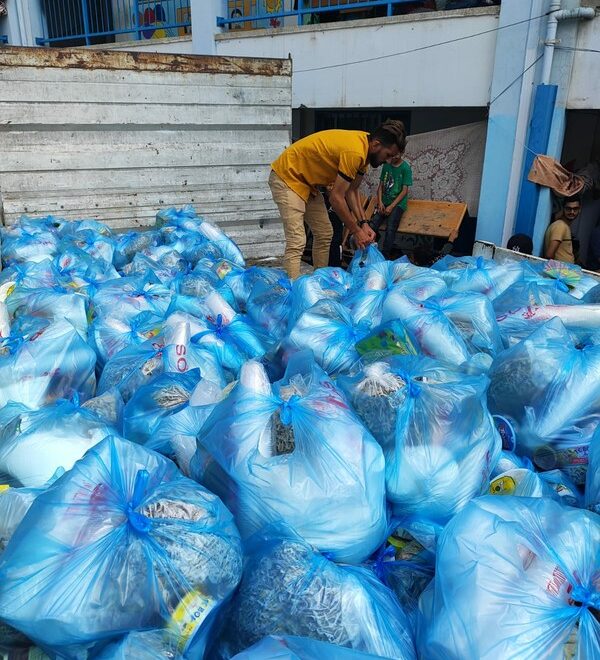Gaza is in the midst of an unprecedented and totally avoidable hunger crisis, with every single person in the territory now experiencing extreme levels of hunger. The UN’s Food and Agricultural Organisation (FAO) reports that the entire 2.3 million population is currently classified as facing either crisis, or emergency or catastrophic levels of food insecurity. Moreover, an increasing number of people are on the brink of famine-like conditions, a result of more than four months of constant bombardment and a siege on the strip.
There is hardly any food available for people to buy, and prices are very high, while the distribution of food aid is limited and inconsistent. Heba, a displaced mother who is now staying in the classroom of a school shelter with her family, said:
“If you buy a kilo of lentils it costs 20 shekels [$5.55]. It was originally 10 shekels [$2.77]. Yeast costs 35 shekels [$9.71]. With difficulty, they bring us [food] vouchers but it is not enough…It gives us just a can of beans and a can of chickpeas for a family of seven.”
Damage to infrastructure from airstrikes has made local food production almost impossible. A geospatial assessment carried out by the UN Satellite Centre found that more than a third of Gaza’s arable land had been damaged, while most fishing boats in the territory and many bakeries and mills have been destroyed.
Clean water is scarce, leaving many people with no option but to drink unsafe and contaminated water. Mahmoud, who is currently living in a camp for displaced people in the south, said:
“The water that’s available for the public is unhealthy. It is unsanitary and not suitable for human consumption. It is loaded with salts and germs, and it isn’t sanitized. The issue with this water is its high saline levels, which leads to urinary problems in terms of kidney stones and urinary sediment and many other issues.”
A lack of fuel and cooking gas means families are burning anything they can find to cook what little food they have, with potentially dangerous health consequences. Sohad, a 23-year-old displaced mother who is currently staying on a beach in a tent with her family, said:
“We live on sand and now we burn plastic to cook with. We have not found anything to eat. We have not found anything to feed our children.”
Pregnant women and children under five are amongst the most impacted by the lack of food and clean water, with UNICEF warning that child wasting – the most dangerous kind of malnutrition in children – could soon affect up to 10,000 children in Gaza. Bisan, 29, a mother of six, who gave birth after being displaced from her home in northern Gaza, said:
“I have difficulty breastfeeding my son. There is no milk, and he keeps vomiting. Prices are high and milk is expensive. Even the price of milk [has] risen. A tin of milk costs 70 or 80 shekels [$19.41 or $22.19]. I cannot provide one tin of milk for my son.”
Balsam, a nutritionist in Gaza, said:
“Tinned food is the only available source of food here in Gaza. They contain large amounts of salt. That, by itself, is a major issue. Especially for people with illnesses. Salt in tinned food isn’t good for people with blood pressure problems. Children are also affected by the high salt content, as it causes infections… Pregnant women are also affected… Even if these issues aren’t noticed immediately, they have greater long-term effects in the future, which will cause many illnesses.”
Despite the clear and desperate need for food and clean water, the amount of aid currently being allowed into Gaza each day is shamefully insufficient – averaging just a fifth of the pre-October 7 levels. This must be scaled up immediately if there is to be any hope of staving off widespread famine.
Riham Jafari, Advocacy and Communications Coordinator at ActionAid Palestine, said:
“It is appalling to watch the world standing by as the people of Gaza slowly starve in what is a completely avoidable catastrophe. The recent International Court of Justice ruling clearly stated that the supply of humanitarian aid into Gaza must be facilitated yet instead, people have grown hungrier by the day.
The situation is most bleak in the north of Gaza, where some 300,000 people are almost completely cut off from humanitarian assistance. People who were so desperate that they were resorting to grinding up animal feed to use as flour are now finding that even this poor substitute is completely running out.
As grim as the picture is, things will get substantially worse if Israel proceeds with its plans for a full military operation in Rafah, which is the main center of aid distribution for the entire strip. Aid operations will grind to a complete halt, denying a lifeline to hundreds of thousands of people. The consequences are unimaginable. Governments around the world must do everything in their power to prevent a further onslaught in Rafah and push for a permanent and immediate ceasefire. It’s the only way to stop the indiscriminate killing of civilians, allow aid to enter Gaza and be distributed safely at scale to prevent famine and deadly disease outbreaks.”
ENDS
For media requests, please email Jenna.Farineau@actionaid.org or call 202-731-9593.
Spokespeople are available:
- Niranjali Amerasinghe, Executive Director of ActionAid USA
- Riham Jafari, Coordinator of Advocacy and Communication for ActionAid Palestine
About ActionAid
ActionAid is a global federation working with more than 41 million people living in more than 71 of the world’s poorest countries. We want to see a just, fair, and sustainable world, in which everybody enjoys the right to a life of dignity, and freedom from poverty and oppression. We work to achieve social justice and gender equality and to eradicate poverty.
